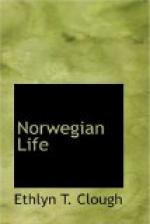Notwithstanding these warlike aspects, a peaceful dissolution of the union between Sweden and Norway was finally effected. The conference at Karlstad between the representatives of the two nations, on Sept. 23, 1905, drew up a protocol which became a treaty when subsequently ratified by the Riksdag and the Storthing, on the ninth of the following October. Thereupon Sweden canceled the charter of 1815 which governed the union of the two countries, and King Oscar declared Norway to be again separate and independent. Thus were severed the political relations between two countries, which, during a period of ninety years, had led to ever-increasing discord.
King Oscar II of Sweden steadfastly refused, however, to allow any prince of his house to be chosen as the new king of Norway, and the choice finally fell upon Prince Charles of Denmark, who was elected by an overwhelming majority at the plebiscite held throughout Norway on Nov. 12, 1905. He accepted the throne offered him and was crowned June 22, 1906.
The idea is prevalent that there is ill will between the Norwegian and Swedish peoples. This is a popular misconception. The Norwegian and Swedish peoples are racially very similar in character and habits, and mutually respect each other. King Oscar was as beloved and honored in Norway as he was in Sweden, and deservedly so. The Norwegians felt proud of his character, life, and statesmanship. They appreciated his wisdom and moderation, and gave him full credit for his earnest conviction that he was right in his differences with the Norwegian government. And yet, the dissolution was a blessing to both countries concerned. So long as Norway and Sweden were united under one king, there would have been friction. In like manner the long union between Norway and Denmark was a continuous source of irritation, but after the dissolution they were the best of friends. It has been suggested that Russia has long had her eye on the ice-free harbors of the Norwegian coast and




